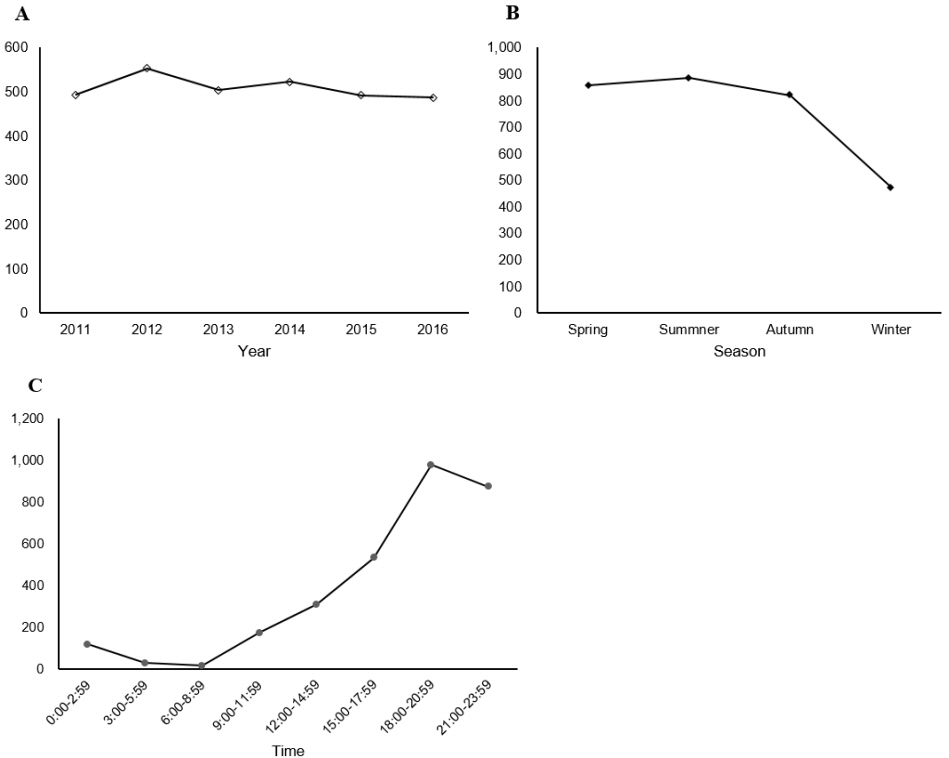Pediatr Emerg Med J.
2021 Dec;8(2):87-94. 10.22470/pemj.2021.00276.
Epidemiologic features of pediatric genital injury in emergency departments in Korea
- Affiliations
-
- 1Department of Emergency Medicine, Seoul National University Hospital, Seoul, Korea
- 2Department of Emergency Medicine, Samsung Medical Center, Seoul, Korea
- 3Department of Emergency Medicine, SMG-SNU Boramae Medical Center, Seoul, Korea
- 4Department of Emergency Medicine, Seoul National University Bundang Hospital, Seongnam, Korea
- KMID: 2524000
- DOI: http://doi.org/10.22470/pemj.2021.00276
Abstract
- Purpose
Genital injury is a common pediatric injury. Given the lack of nationwide data, the authors aimed to show age group-related epidemiologic features of genital injury in Korea.
Methods
We reviewed the data from 2011-2016 Emergency Department-based Injury In-depth Surveillance registry, which involves 23 emergency departments in Korea. From the dataset, we included children (< 18 years) with the International Classification of Diseases, 10th Revision codes related to genital injury as the final diagnosis with excluding those with other codes or combined injuries. Age groups were defined as follows; infants (< 1 year), toddlers (1-3), preschoolers (4-6), schoolers (7-12), and adolescents (13-17). The clinical features and outcomes were analyzed.
Results
A total of 3,030 children were included with the median age of 6 years (interquartile range, 4-10) and the proportion of girls of 53.0%. Only 144 children (4.8%) were transported by the emergency medical service providers. The most common mechanism and place were blunt injury (1,826 [60.3%]) and home (1,535 [50.7%]), respectively. Of the codes, “Contusion of external genital organs (S30.2)” was most common (1,574 [51.9%]). As for outcomes, 2,770 children (91.4%) were discharged, 252 (8.3%) were hospitalized (intensive care units, 1 child [0.03%]), and 108 (3.6%) underwent surgery. Severe injury occurred in 111 children (3.7%) without a mortality. With increasing age in the age groups, non-accidental injury, school and sports-related injuries, hospitalization, and surgery (All Ps < 0.001).
Conclusion
Genital injury may occur at evening, in spring and summer, at home, and in the form of accidental or blunt injury. Most children are discharged. Contrary to these general features, older children tend to undergo more frequently non-accidental injury, school and sports-related injuries, hospitalization, and surgery. Thus, we need age-specific strategies for injury prevention.
Figure
Reference
-
References
1. Casey JT, Bjurlin MA, Cheng EY. Pediatric genital injury: an analysis of the National Elec-tronic Injury Surveillance System. Urology. 2013; 82:1125–30.
Article2. Benjamins LJ. Genital trauma in pediatric and adolescent females. J Pediatr Adolesc Gyne-col. 2009; 22:129–33.
Article3. Spitzer RF, Kives S, Caccia N, Ornstein M, Goia C, Allen LM. Retrospective review of un-intentional female genital trauma at a pediatric referral center. Pediatr Emerg Care. 2008; 24:831–5.
Article4. Chang AJ, Brandes SB. Advances in diagnosis and management of genital injuries. Urol Clin North Am. 2013; 40:427–38.
Article5. Kim K, No JH, Kim YB, Lee JH, Rhee JE. Patterns of accidental genital trauma and factors associated with surgical management in girls visiting the emergency department of a referral center. J Pediatr Adolesc Gynecol. 2014; 27:133–7.
Article6. Korea Disease Control and Prevention Agency. Emergency Department-based Injury In-depth Surveillance [Internet]. Cheongju (Korea): Korea Disease Control and Prevention Agency;c2021 [cited 2021 May 27]. Available from: https://kdca.go.kr/contents.es?mid=a20303010600. Korean.7. Korea Disease Control and Prevention Agency. Integrated Disease and Health Management System [Internet]. Cheongju (Korea): Korea Disease Control and Prevention Agency;c2021 [cited 2021 May 27]. Available from: https://is.kdca.go.kr/. Korean.8. Korea Disease Control and Prevention Agency. Korea Disease Control and Prevention Agency Injury Information Portal. Emergency Department-based Injury In-depth Surveillance guidebook [Internet]. Cheongju (Korea): Korea Disease Control and Prevention Agency;c2021 [cited 2021 May 27]. Available from: http://www.kdca.go.kr/injury/biz/injury/recsroom/examinGudbkMain.do. Korean.9. Takei H, Nomura O, Hagiwara Y, Inoue N. The management of pediatric genital injuries at a pediatric emergency department in Japan. Pediatr Emerg Care. 2021; 37:73–6.
Article10. Adu-Frimpong J. Genitourinary trauma in boys. Clin Pediatr Emerg Med. 2009; 10:45–9.
Article
- Full Text Links
- Actions
-
Cited
- CITED
-
- Close
- Share
- Similar articles
-
- Epidemiologic features according to age groups of pediatric dental injury in emergency departments
- Characteristics of pediatric genital injuries: a 10-year, single-emergency center, retrospective study
- Epidemiologic characteristics of children who visited an emergency department: a single center study over three years
- Management of abdominal pain in pediatric emergency departments
- Association between Time of Injury and Injury Severity after Pediatric Pedestrian Injury



